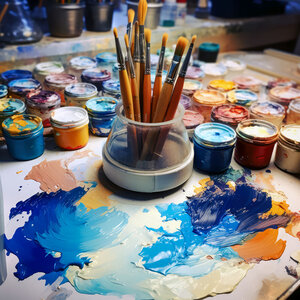Acrylic paint
|
|
Acrylic paint is fast-drying paint containing pigment suspended in an acrylic polymer resin. Acrylic paints can be diluted with water, but become water-resistant when dry. Depending on how much the paint is diluted (with water), the finished acrylic painting can resemble a watercolor or an oil painting.
Acrylic painting is a versatile and popular form of visual art that involves the use of acrylic paints, which are pigments suspended in a water-based polymer emulsion. This type of paint has gained widespread popularity among artists due to its fast-drying nature, vibrant colors, and flexibility in application.
Characteristics of Acrylic Painting
- Quick Drying Time: One of the key features of acrylic paint is its rapid drying time. Unlike oil paints, which can take days or even weeks to dry, acrylics dry quickly, allowing artists to layer colors, add details, or make corrections in a relatively short timeframe.
- Versatility: Acrylics can be applied to a variety of surfaces, including canvas, wood, paper, and fabric. This adaptability makes acrylic painting suitable for a range of artistic expressions, from traditional canvas paintings to more experimental mixed-media works.
- Vibrant Colors: Acrylic paints are known for their intense and vibrant colors. Artists can create a wide spectrum of hues by mixing colors or diluting them with water. The paint can also be applied in thin glazes or thick impasto strokes, providing a broad range of textural possibilities.
- Layering and Blending: Artists can build up layers of paint on the canvas, allowing for intricate detailing and the creation of a sense of depth. Acrylics also allow for wet-on-wet blending, enabling artists to seamlessly merge colors on the canvas.
- Opacity and Transparency: Acrylic paints can be used in various consistencies, from opaque to transparent. This flexibility allows artists to create translucent washes or build up opaque layers, adding to the complexity and visual interest of the artwork.
- Permanent and Durable: Once dried, acrylic paintings are generally permanent and resistant to yellowing or cracking over time. The durability of acrylics makes them a preferred choice for many artists who want their works to stand the test of time.
- Clean-up and Storage: Since acrylic paints are water-based, they are easy to clean up with water, making them more user-friendly compared to oil paints. Additionally, acrylics do not require the use of solvents, reducing the environmental impact. Artists can store unused paint for future use by allowing it to dry on a palette.
Popular Techniques in Acrylic Painting
- Dry Brushing: Using a brush with minimal paint to create a textured or scratchy effect
- Impasto: Applying thick layers of paint to create a three-dimensional, textured surface.
- Glazing: Layering translucent colors to create a luminous effect.
- Sgraffito: Scratching or scraping into wet paint to reveal layers underneath.
- Pouring: Thinning acrylic paint and pouring it onto the canvas for abstract and unpredictable patterns
Acrylics are sometimes used in place of watercolors because acrylics dry closer to the desired color (slightly darker, usually) while watercolors dry lighter (and often unpredictably, especially for beginning artists).
Acrylics are often used as an alternative to oil paints because acrylics dry much faster. Oil paints, which consist of pigment suspended in an oil (usually linseed, or other natural oil) base, can take a very long time to dry. Acrylic paints can achieve an oil-paint-like effect, and do so in much less time. Though applied to look like oil paints, acrylics are somewhat limited due to the superior color range of oil paints, and the fact that acrylic paints dry to a shiny, smooth (some say 'cartoonish') effect—not surprising since acrylic paints are, basically, plastic. Accordingly, acrylic paint can be removed with turpentine, mineral spirits (also known as white spirits), ammonia, or rubbing alcohol.
Acrylic painters modify the appearance, hardness, flexibility, texture, and other characteristics of the paint surface using acrylic mediums. Watercolor and oil painters also use mediums, but the range of acrylic mediums is much greater. Acrylics have the ability to bond to many different surfaces, and mediums can be used to adjust their binding characteristics. Mediums can change the sheen from gloss to matte, or can add iridescence or texture to the surface. They can also be used to build thick layers of paint: gel and molding paste mediums are sometimes used to create paintings with relief features that are literally sculptural.




